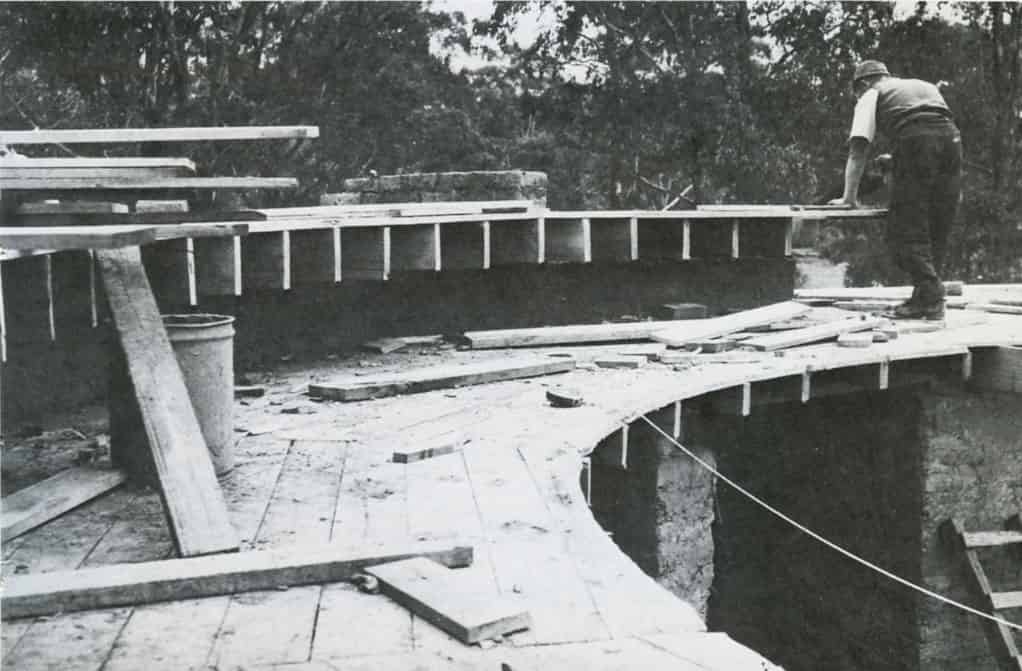Horry Judd
 Horrie Judd in a typical pose at work on the Periwinkle house
Horrie Judd in a typical pose at work on the Periwinkle house
On first meeting Horrie Judd
It all came to be more than Sonia [then Knox's foreman] could keep up with, partly because of her transport limitations [a horse named Sherry] and partly because she was a natural worker rather than a supervisor. One evening after dining at Montsalvat we went to speak to Horrie Judd, a building-labourer foreman who was reputed to be almost as strong as Hercules.
Our journey lay on the other side of Diamond Creek and over the steep, arena-like hills that surrounded the valley to their highest point. We found ourselves engulfed in aniseed weed and thistles that were taller than we were. As the daylight gave way to a full moon rising in the east behind us, we were like strangers lost in a primaeval jungle. Eventually we battled our way into Horrie's half-completed shack and saluted the object of our search, who was seated at a table and reading by lamplight.
He fitted the scene perfectly. Though he was of barely average height, his arms gave unmistakable evidence of great strength. As he stood up, we saw a slight stoop in him, which was obviously the result of heavy lifting and digging hour after hour, week after week. He looked like the kind of human troglodyte who would have been honoured as a Stakhanovic and in every respect the antithesis of Wynn Robert, John Yule, and even Larry Stevens. This was the man Sonia and I had been searching for to take the pain out of mud-brick building for the middle class, a village labourer born two hundred years out of his right time.
The room that branched off from where we met him had a generally untidy appearance, complete with stacks of newspapers in the corners. He explained that the house was not finished. He had put up the present structure in two weekends a couple of years earlier, and had yet to complete it. So great was the demand both for Horrie Judd's willingness to work and his work capacity that as far as I am aware, the house was still unfinished at the time of his death nearly forty years later, when he was mourned by all those who had ever employed him. He was at some pains to explain to us that first night that he was not a tradesman per se, but rather a foreman labourer.
Jorgie [Justus Jorgenson of Montsalvat], who had used him at various times, would become lyrical as he described Horrie's ability to dig holes in those days, when such work was still done by hand. 'He would just start digging', Jorgie would say, 'and in a few minutes would begin to disappear from sight feet-first as the shovel rose and fell with piston-like precision'. Horrie Judd was the epitome of undertaking the impossible labouring task without looking up.
This was the real beginning of my major early earth-building period and close association with Horrie Judd, which continued for some years. We eventually parted company because of his inability to delegate work to his subordinates. He saw them merely as long-haired intellectuals - only to be entrusted with cleaning-up chores, while he set about doing their specified work in addition to his own. He considered Gordon Ford an exception because of his physical strength and Scottish endurance and stubbornness.
Horrie at work
Horrie's criterion for success was the amount of that commodity [hard work] that could be accomplished in a given time. His arrival had brought about an entirely new sense of urgency that was having an impact on the permanent semi-holiday spirit among the fringe members of the staff. He gauged that Gordon Ford was his best chance of finding a serious worker who could make building his lifetime calling, so he chose him to work on the slab at Phyl Busst's house. Phyl was considered rich and artistic, and as concrete trucks had not yet made their debut in Melbourne, Horrie decided that he and Gordon should perform the herculean task without the assistance of any machinery. The lower slab would be mixed and poured using only shovels, muscle, sweat, and bull-headedness. In one day they mixed fifty-five bags of cement with more than ten tons of sand and screenings and placed it all in situ in the most memorable day's work the community ever saw. They stood opposite each other and turned over the whole mix four times - twice dry, twice wet - as they moved it down the slope to its final location. Horrie was correct in choosing Gordon Ford, who had that Scottish tenacity to work till he dropped. As the day progressed each man gained an appreciation of the other's inflexibility that never changed through the years. Gordon became a landscape-architect contractor whose great specialty was manhandling large-scale stonework, and Horrie finished up erecting the bluestone chapel at Montsalvat almost single-handed nearly thirty years later.
